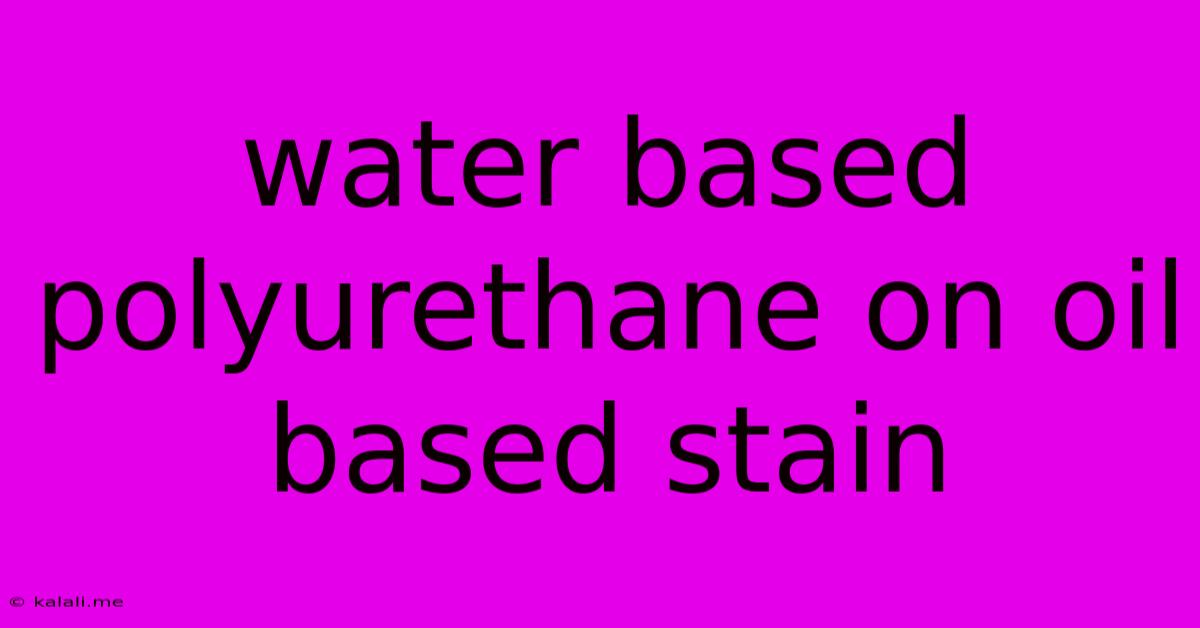Water Based Polyurethane On Oil Based Stain
Kalali
May 24, 2025 · 4 min read

Table of Contents
Can You Use Water-Based Polyurethane Over Oil-Based Stain? A Comprehensive Guide
Applying a protective topcoat over your beautifully stained wood is crucial for longevity and beauty. But what happens when you've chosen an oil-based stain and now face the decision of which polyurethane to use? This article will delve into the complexities of using water-based polyurethane over oil-based stain, exploring the pros, cons, and crucial steps for a successful finish. Understanding this process is key to achieving a durable and stunning final product for your woodworking projects.
Understanding the Chemistry: Oil vs. Water-Based Products
Before jumping into the application process, let's quickly recap the differences between oil-based and water-based products. Oil-based stains penetrate deep into the wood grain, providing rich color and excellent protection. However, they often require longer drying times and have strong, lingering odors.
Water-based polyurethanes, on the other hand, are low-VOC (volatile organic compound), dry faster, and clean up easily with soap and water. Their quick drying time and ease of use are significant advantages for many DIYers. However, the compatibility with oil-based stains is a crucial consideration.
The Challenge: Adhesion and Compatibility
The main issue with applying water-based polyurethane over oil-based stain lies in adhesion. Water-based polyurethane relies on the wood surface being slightly porous to properly bond. Oil-based stains, due to their penetrating nature, can create a less porous surface, potentially hindering the polyurethane's ability to adhere effectively. This can lead to peeling, chipping, or a less durable finish.
Can it be done? Yes, but with caution.
While directly applying water-based polyurethane over oil-based stain isn't ideal, it's not impossible. The key is proper preparation and understanding the limitations. A poorly prepared surface will almost certainly result in a subpar finish.
Preparing for Success: Key Steps for Application
Here's a step-by-step guide to help you achieve the best possible results when applying water-based polyurethane over oil-based stain:
-
Thorough Drying: Ensure your oil-based stain is completely dry before proceeding. This often takes significantly longer than what the stain's label indicates. Allow for ample drying time, possibly several days, depending on the wood type, temperature, and humidity.
-
Light Sanding: Lightly sand the stained surface with fine-grit sandpaper (220-grit or higher). This will help to slightly roughen the surface, creating better adhesion for the polyurethane. Remove all sanding dust with a tack cloth. Be gentle; you don't want to remove the stain.
-
Degreasing: Use a clean cloth slightly dampened with mineral spirits (carefully following safety precautions) to remove any excess oil or residue from the stain. This further enhances adhesion. Allow it to completely dry.
-
Primer (Optional but Recommended): Applying a high-quality bonding primer specifically designed for use over oil-based finishes will provide a strong foundation for your water-based polyurethane. This extra step significantly improves adhesion and is highly recommended, especially for critical projects.
-
Thin Coats: Apply thin, even coats of water-based polyurethane. Avoid applying too much at once, as this can lead to bubbling, sagging, and uneven drying. Allow each coat to dry completely before applying the next, following the manufacturer’s drying time recommendations.
-
Light Sanding Between Coats (Optional): For a super smooth finish, lightly sand between coats with very fine grit sandpaper (320-grit or higher). Again, remove all sanding dust with a tack cloth.
-
Final Inspection: Once the final coat is dry, inspect the finish carefully. If there are any imperfections, you may need to lightly sand and re-apply a final coat to perfect the result.
Alternative Approaches:
If you're concerned about compatibility issues, consider using an oil-based polyurethane instead. It provides better adhesion with oil-based stains and generally results in a more robust finish. However, keep in mind the longer drying times and stronger odor associated with oil-based products.
Conclusion
While it's possible to apply water-based polyurethane over oil-based stain, it requires careful preparation and attention to detail. By following these steps, you can increase your chances of achieving a successful and durable finish. However, if you're seeking the easiest path to a beautiful and long-lasting finish, choosing compatible finishes (oil-based over oil-based, or water-based over water-based) is always the most reliable approach. Remember to always prioritize safety and follow the manufacturer's instructions on all products used.
Latest Posts
Latest Posts
-
Blender Bake Light Texture With Tonemapping
May 25, 2025
-
Ical The Server Responded With An Error
May 25, 2025
-
Why Is The Wicked Witch Green
May 25, 2025
-
Write The Exact Answer Using Either Base 10 Or Base E Logarithms
May 25, 2025
-
Google Sheets Script Save Range As Variable
May 25, 2025
Related Post
Thank you for visiting our website which covers about Water Based Polyurethane On Oil Based Stain . We hope the information provided has been useful to you. Feel free to contact us if you have any questions or need further assistance. See you next time and don't miss to bookmark.